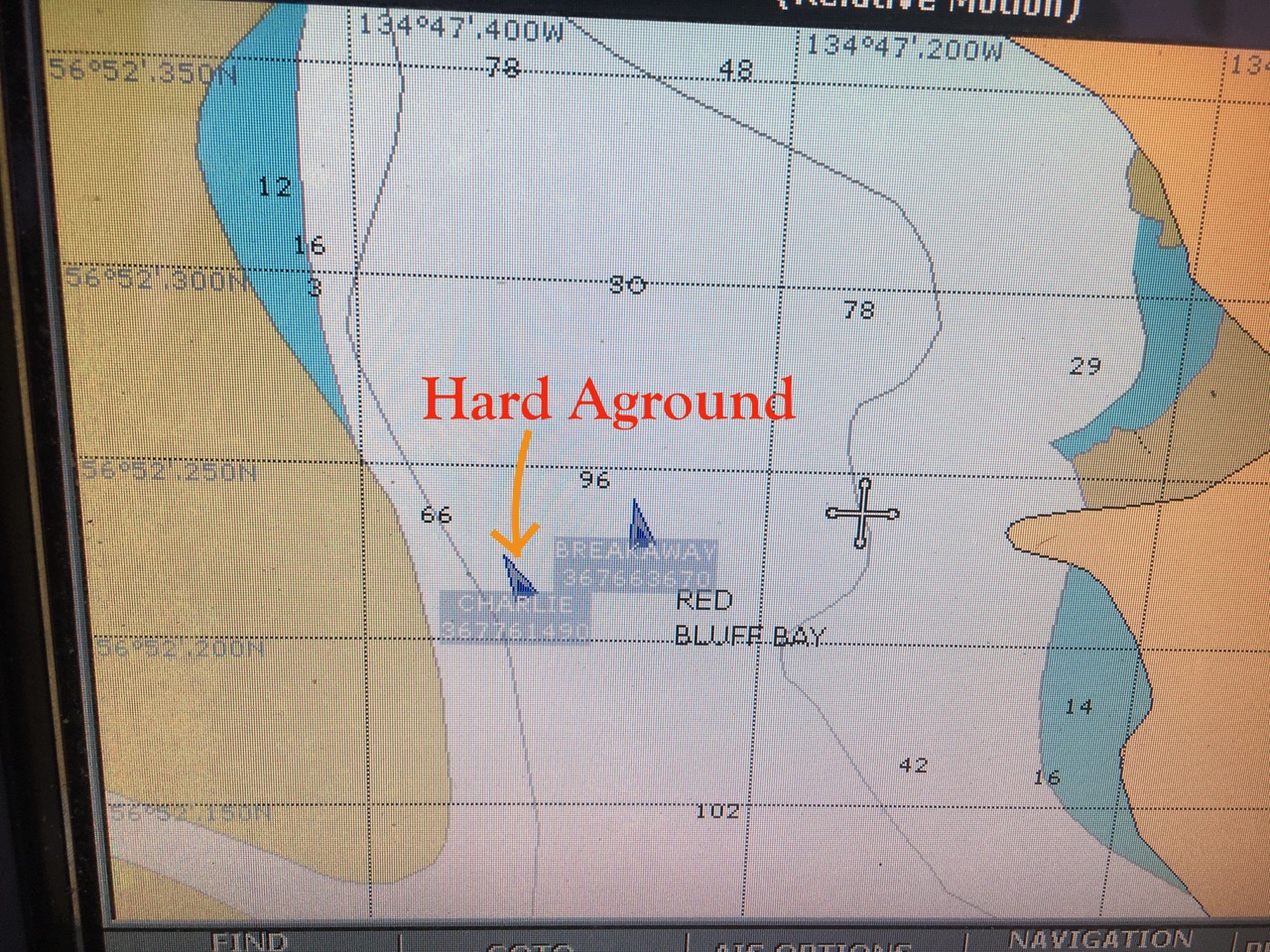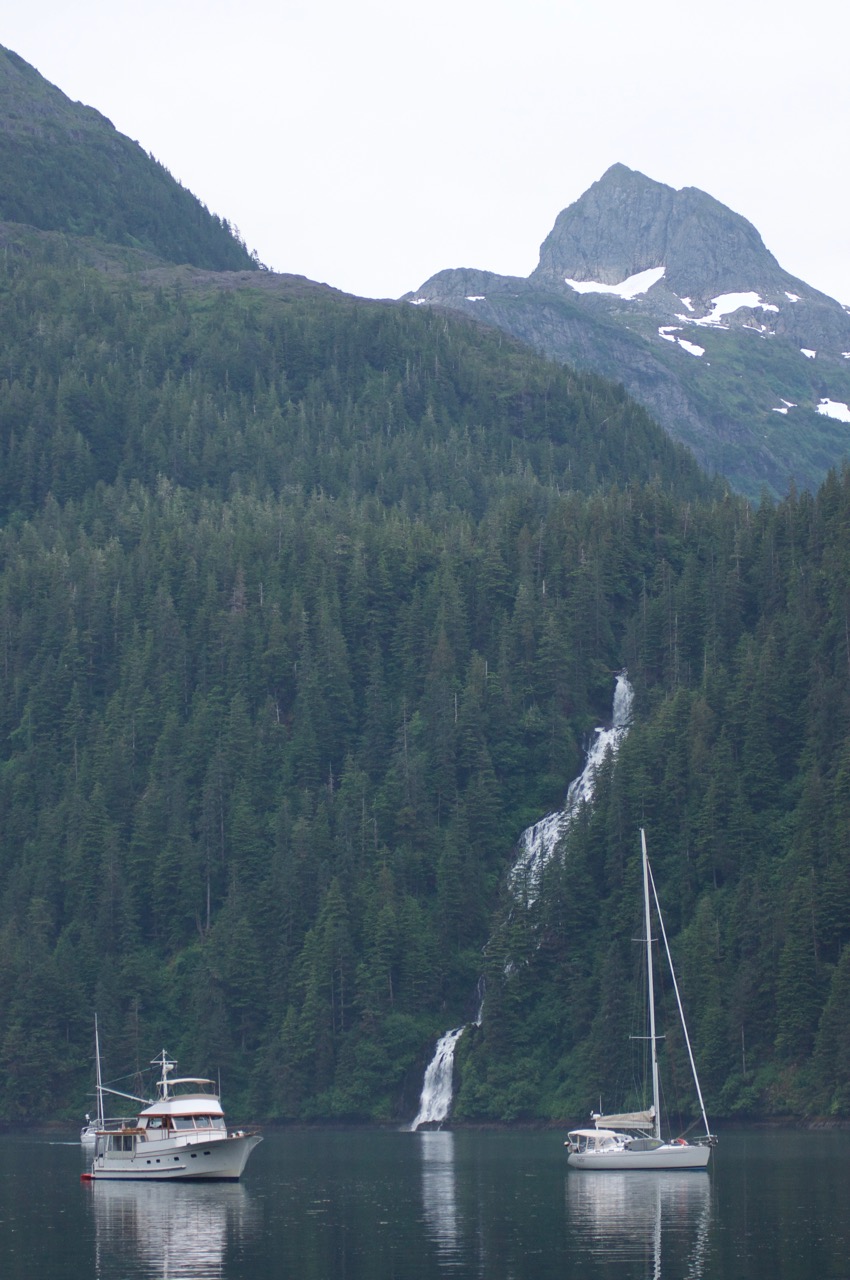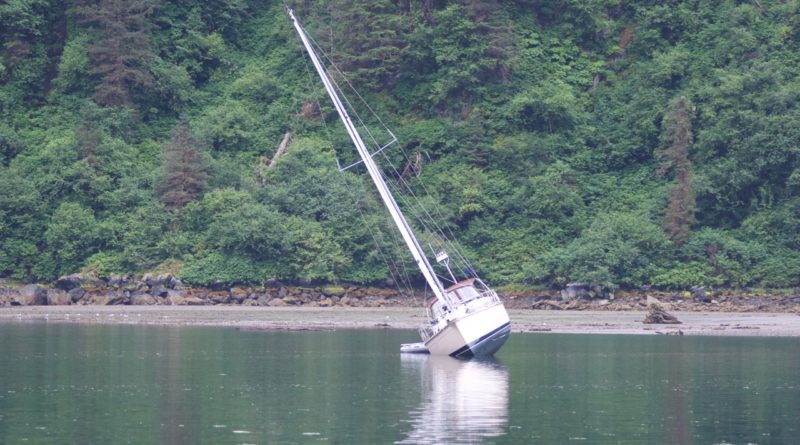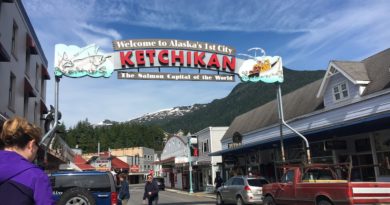Red Bluff Bay
It suddenly got cold today. We started out our morning with a mild 60 degrees or so in Rocky Pass Bay. Then we made a stop in Kake for fuel, and a few provisions from the mini-mart. The weather in Kake was quite mild as well. But then, we spent our evening hours crossing a placid Chatham Strait, and we felt the temperature slowly drop.
Even in the comfort of our fully enclosed cockpit, the significant change in temperature was noticeable. Despite the fact that Red Bluff Bay has a slightly lower latitude, its side of the strait was about 10 degrees cooler than the temperatures we had in Kake.
As we crossed Chatham Strait, the terrain confirmed what we’d already felt in the air – to the east, toward Kake, the mountains rose up blue and green. To the west, across the strait, glaciers dominated rocky mountain peaks, reaching down barren cliffs to within less than a few thousand vertical feet of the coast.
Except for the change in landscape, the day was fairly uneventful. As usual, the fleet’s 9:30 departure ended up occurring half an hour early, leaving us scrambling to raise the anchor and keep up. We left Rocky Pass Bay on a spring minus tide (minus 4.1), and dodged reefs and rocks during our two-hour passage to Kake. Luckily, the reefs and rocks were well-charted, which is becoming the exception rather than the rule as we continue our journey northward.
We thought we may stay the night in Kake, and take an afternoon and part of the next morning to fuel, shower, do laundry, and get some fresh fruits and veggies. When we arrived, we quickly changed our plans; there was no real fuel dock. Instead, we tied up to the public dock, and the nearby fuel station brought a fuel truck down to pump gas into all the waiting tanks. We also discovered that there were no public showers, so the best we could do on the shower front was to shower on-board, and refill our water tanks from the shore water as we drained them. Laundry wasn’t even an option – the locals confirmed there was a not a single laundromat in town. The grocery store was a few miles down the road, and we could get there either by calling the town’s single taxi driver, or finding a friendly local willing to help out in exchange for a nice tip. We opted to make due with a trip to the nearby mini-mart, where we felt quite at home, surrounded by Kirkland Signature products (but certainly not commensurate prices). Three small bags of groceries and $100 later, the girls and I walked back to the boat, while Rich finished filling our propane. Then, we used our 128-kbps cellular data connection to spend the next two hours downloading a single library book, and uploading just two blog posts. Fed up with the internet connection, we untied and made our way across the strait to Red Bluff Bay.
We had been sternly warned, during the prior evening’s briefing, not to go ashore in Red Bluff Bay. In particular, none of the dogs should go on shore. There was a large meadow there, which a dog would love to run around, but also a large, salmon-bearing river running through it. In these parts, salmon runs meant bears. Although we didn’t see a bear during our stay, brown bears lounging in the grass, hidden, was not an uncommon occurrence here. So, all canines and their companions were to stay on board their vessels. Humanoid counterparts were cautioned to go ashore only if equipped with bear spray and a shotgun.
That didn’t mean that we couldn’t get a good, close-up look at the bears, however. Our admiral explained that brown bears were fast on land; but they slowed up significantly once shoulder-deep in water. So, a kayak in bear-shoulder-deep water could easily outswim an angry or hungry brown bear. Despite this ingenious bear-viewing technique, we opted to leave our kayak on-deck, and limit our viewing to whatever could be seen from our cockpit. The most interesting thing we saw were numerous salmon leaping out of the water near the mouth of the stream and landing on their sides. I think The Admiral had said a few days ago that those were pink salmon, trying to loosen their eggs for spawning.
Minor tragedy befell one of our comrades at Red Bluff Bay. About an hour away from the anchorage, we heard the call on the radio: “Ruby Slippers, this is Charlie. We’re on the gravel.” The Admiral responded that they better get off of there quickly, because the tide was going down. Poor Charlie’s crew was bewildered – their own charts, and their AIS plot on the fleet’s charts, showed that they should have at least 60 feet of water under their keel. Their keel, however, confirmed that was not the case.
After a few minutes of trying to power off the gravel shoal, the tide had sunk too low for Charlie to do anything but sit and wait. While she waited, the tide receded approximately 3 feet. This never left Charlie dry, but she was listing at least 50 degrees waiting for the water to rise. An hour and a half later, the tide finally started to rise. Another two hours, at about 10:30 PM, and Charlie was finally free of her gravelly perch. Rich and I finally had the drama-filled anchor show we’d joked about every evening since starting our trip. Our fully enclosed cockpit, plus a few extra layers of clothing, kept us warm and cozy for the duration of the show, until we finally headed off to bed.








